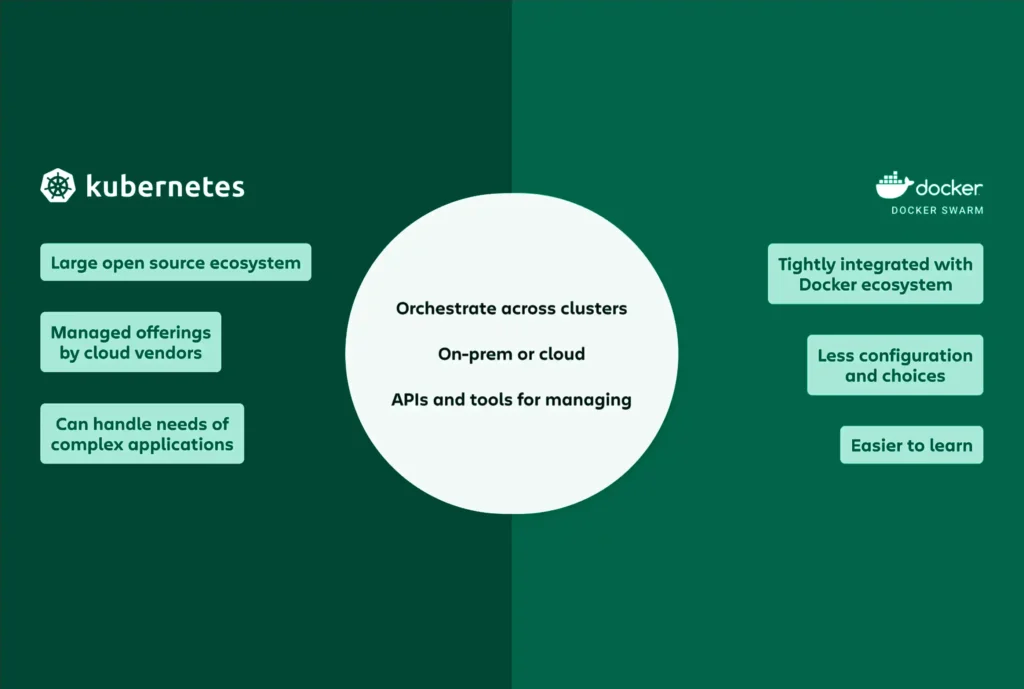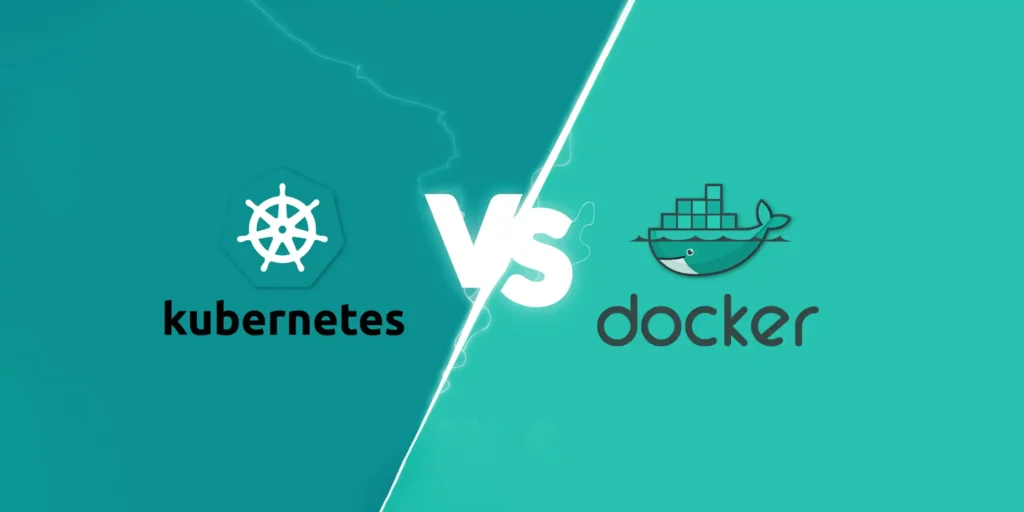Two prominent technologies in this area are Kubernetes and Docker. Both Kubernetes and Docker play important roles in field control and orchestration, permitting companies to effectively manage their programs at scale.
Introduction
Docker, first released in 2013, is an open-source platform that simplifies the technique of creating, deploying, and running programs using containers. Containers permit builders to package an application and its dependencies into a standardized unit that can run consistently throughout distinctive environments. Docker presents a lightweight and transportable answer for building and distributing those boxes.

On the other hand, Kubernetes is an open-source container orchestration platform that was initially advanced with the aid of Google. It provides a sturdy framework for automating the deployment, scaling, and control of containerized applications throughout clusters of hosts. With Kubernetes, groups can, without problems, control complicated deployments related to multiple containers walking on special machines or cloud instances.
The combination of Docker’s containerization skills with Kubernetes’ powerful orchestration capabilities has become a famous preference for current software development. By leveraging these technologies collectively, builders can without difficulty set up their applications in a scalable way while ensuring high availability and fault tolerance.
We can delve deeper into the functionalities supplied by both Kubernetes and Docker. We will discover how they work together to permit green box control and orchestration within present-day IT infrastructures. Additionally, we can talk about some common-use instances wherein those technologies have proven to be invaluable gear for corporations in search of ways to streamline their software deployment processes.
So, let’s dive into the sector of Kubernetes and Docker to recognize how they may be remodeling the way we increase and manage our software program applications.
What is Docker, and How Does It Simplify the Deployment of Applications?
Docker is a containerization era that simplifies the deployment of applications. It permits developers to package their programs and all their dependencies into Docker packing containers, which can then be deployed without difficulty on any gadget that has the Docker engine set up.
The concept of containerization is in the middle of Docker. A field is a lightweight, standalone executable package that includes everything needed to run an application: code, runtime, device tools, libraries, and settings. By encapsulating the application and its dependencies within a field, Docker guarantees that it runs continually throughout one-of-a-kind environments.
One of the key benefits of using Docker for utility deployment is its portability. Containers are isolated from one another and from the underlying host machine, making them relatively portable throughout extraordinary running structures and infrastructure setups. This method means that builders can construct a utility once in a Docker box and then install it on any machine without annoying compatibility problems.
Docker also provides scalability and flexibility in deploying applications. With Docker’s ability to quickly spin up multiple instances of bins primarily based on pre-defined photos, builders can without problems scale their applications horizontally to handle multiplied traffic or calls.
Docker simplifies the control and upkeep of applications. It provides a constant environment for improvement teams by making sure that everybody works with the same set of dependencies and configurations. Updates or adjustments to a utility may be made by actually developing a new edition of the box photograph rather than modifying individual components or configurations.
Docker revolutionizes software deployment by leveraging containerization technology. It simplifies the procedure by encapsulating applications within boxes, making them transportable, scalable, and easier to manipulate.
Introduction to Kubernetes: The Powerhouse of Container Orchestration
Kubernetes, frequently known as K8s, is a powerful open-source container orchestration platform that has gained monstrous popularity in recent years. It presents a strong and scalable answer for handling containerized programs, making it the go-to choice for builders and system directors.
At its core, Kubernetes offers a wide variety of features that allow green deployment, scaling, and management of containers. Its architecture is designed to address complex tasks that include load balancing, carrier discovery, and automated rollouts and rollbacks seamlessly.
One of the key talents of Kubernetes is its capability to manipulate clusters. It allows users to create multiple nodes or machines that work collectively as a single unit, ensuring high availability and fault tolerance. This cluster management characteristic permits groups to scale their programs easily by adding or doing away with nodes based totally on demand.
Another substantial advantage of Kubernetes is its capability to automate deployment tactics. With Kubernetes, developers can outline the favored kingdom in their software through the use of declarative configuration documents. The platform then looks after automatically deploying and managing the application times based totally on those specs.
Kubernetes serves as a powerhouse for field orchestration by supplying critical features like cluster management and automating deployment approaches. Its architecture ensures scalability and reliability while simplifying the management of containerized applications.
The Role of Kubernetes in Managing Docker Containers at Scale
Kubernetes has emerged as a powerful tool for managing Docker containers at scale. While Docker Swarm also offers field orchestration capabilities, Kubernetes has won huge recognition because of its strong features and huge adoption within the industry.
One of the important roles of Kubernetes is to simplify the management of packing containers by providing a unified platform for deployment, scaling, and monitoring. With Kubernetes, corporations can without difficulty manage and automate the deployment of containerized packages across clusters of machines.
When it comes to managing containers with Kubernetes, it offers numerous blessings. Firstly, it gives declarative configuration and automation capabilities that permit builders to outline the favored nation of their packages using YAML or JSON files. Kubernetes then takes care of making sure that the real state fits the favored nation.
Kubernetes permits horizontal scaling of applications by routinely dispensing workloads across multiple packing containers or nodes primarily based on aid usage. This guarantees efficient usage of assets and advanced software overall performance.
Kubernetes presents integrated health assessments and self-recovery mechanisms that monitor the status of containers and robotically restart or replace them if they fail. This allows for the high availability and reliability of packages while walking in a containerized environment.
In comparison to Docker Swarm, Kubernetes gives superior capabilities, which include service discovery, load balancing, rolling updates, and larger-sized network help. These features make it a great choice for managing containerized applications on a large scale in manufacturing environments.
With its powerful control talents and sizable function set, Kubernetes performs an essential role in simplifying container orchestration and scaling packages efficaciously. Its full-size adoption inside the enterprise is a testament to its cost in dealing with Docker boxes at scale.
Benefits of Using Kubernetes and Docker Together for Container Deployment
The integration of Kubernetes and Docker brings several blessings to field deployment. By leveraging the strengths of each technology, organizations can obtain progress in scalability and availability for their applications.
One of the key advantages of using Kubernetes and Docker together is their stronger scalability. Kubernetes provides a robust orchestration framework that allows for seamless control and scaling of packing containers across a cluster of nodes. With Docker as the underlying containerization technology, builders can, without problems, package and regularly deploy their packages, permitting green scaling as demand fluctuates.
The aggregate of Kubernetes and Docker complements software availability. Kubernetes ensures high availability by robotically managing container placement and distribution across nodes inside the cluster. If a node fails or becomes overloaded, Kubernetes robotically reschedules boxes to wholesome nodes, minimizing downtime and preserving service continuity.
The integration of these two technologies simplifies software deployment techniques. Docker’s standardized container layout permits developers to create portable utility applications that can be effortlessly deployed in any environment, thanks to Docker. Kubernetes then takes care of deploying those boxes across a couple of nodes while coping with their lifecycle.
The use of Kubernetes and Docker collectively offers stepped-forward scalability with the aid of leveraging Kubernetes’ orchestration capabilities with Docker’s green containerization technology. It also enhances software availability through automatic box control and rescheduling in case of disasters or overloads. Together, these technologies offer corporations an effective solution for deploying and dealing with bins at scale while ensuring high performance and reliability for their packages.
How Companies Benefit from Combining Kubernetes and Docker
Combining Kubernetes and Docker has emerged as a popular choice for companies looking to enhance their containerization techniques. This effective combination offers numerous benefits and has caused the adoption of Docker in Kubernetes environments across numerous industries.
One of the most common use cases of this aggregate is in scaling applications. Kubernetes provides a sturdy orchestration platform that lets agencies control and scale their containerized applications seamlessly. By leveraging Docker because of the underlying containerization era, agencies can easily package their applications into transportable and lightweight packing containers, making it easier to set up and scale their usage of Kubernetes.
Another sizable gain is improved aid usage. With Kubernetes, businesses can successfully allocate resources based on software necessities, ensuring excellent performance and value. By using Docker’s lightweight containers, organizations can similarly optimize useful resource allocation by strolling more than one remoted bin on an unmarried host machine.
Combining Kubernetes and Docker permits simplified deployment strategies. Companies can leverage Kubernetes’ declarative configuration approach to outline preferred states for their application deployments. Docker performs an essential role by providing a constant environment for packaging programs in conjunction with all their dependencies, ensuring seamless deployment across different environments.
Several actual international case studies highlight the blessings of combining Kubernetes and Docker. For instance, Spotify followed this combination to streamline their deployment methods, resulting in quicker time-to-market for brand-spanking new features and stepped-forward scalability. The New York Times also leveraged this technology duo to enhance its content material shipping system’s reliability while decreasing infrastructure prices.
The aggregate of Kubernetes and Docker gives several advantages to corporations in search of green containerization strategies. From scaling programs to optimizing useful resource utilization and simplifying deployment techniques, this effective duo has verified its worth in actual-world use cases across diverse industries.
FAQS
Docker is a platform that enables developers to automate the deployment of applications inside lightweight, portable containers. Kubernetes, on the other hand, is a container orchestration platform that automates the deployment, scaling, and management of containerized applications. Docker is often used to create the containers that Kubernetes manages.
No, Kubernetes can work with various container runtimes, but Docker is one of the most popular choices. You can use other container runtimes like Containers or CRI-O with Kubernetes.
Yes, Kubernetes is designed to be container runtime-agnostic. While Docker is commonly used, Kubernetes supports other container runtimes like Containers, CRI-O, and others.
